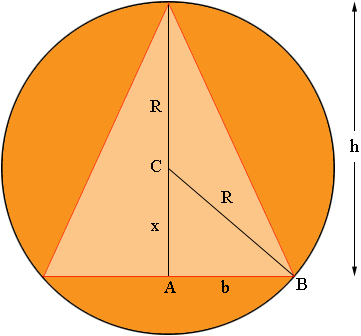| |||
| Math Central | Quandaries & Queries |
|
Question from Anne: Here is the math problem quoted from book: The answer from the key is A(h) = (piR^2) - (h times the square root of I would like to know how the answer was derived, given that we only Thank you for the help. |
Hi Anne,

In my diagram C is the centre of the circle and x is the distance from C to A. Since the triangle is isosceles A is the midpoint of the base. let b = |AB| then b is half the length of the base of the isosceles triangle.
From the diagram h = R + x. Triangle ABC is a right triangle so using Pythagoras theorem
x2 + b2 = R2
Substitute x = h - R and solve for b.
The area inside the circle but outside the triangle is
π R2 - bh
Substitute the value of b you found above and simplify.
Two questions:
What if the base of the triangle passes through C, that is x = 0, does the argument still work?
What if the base of the triangle is above the centre of the circle, that is x < 0, does the argument still work?
Penny
 |
||
Math Central is supported by the University of Regina and The Pacific Institute for the Mathematical Sciences.